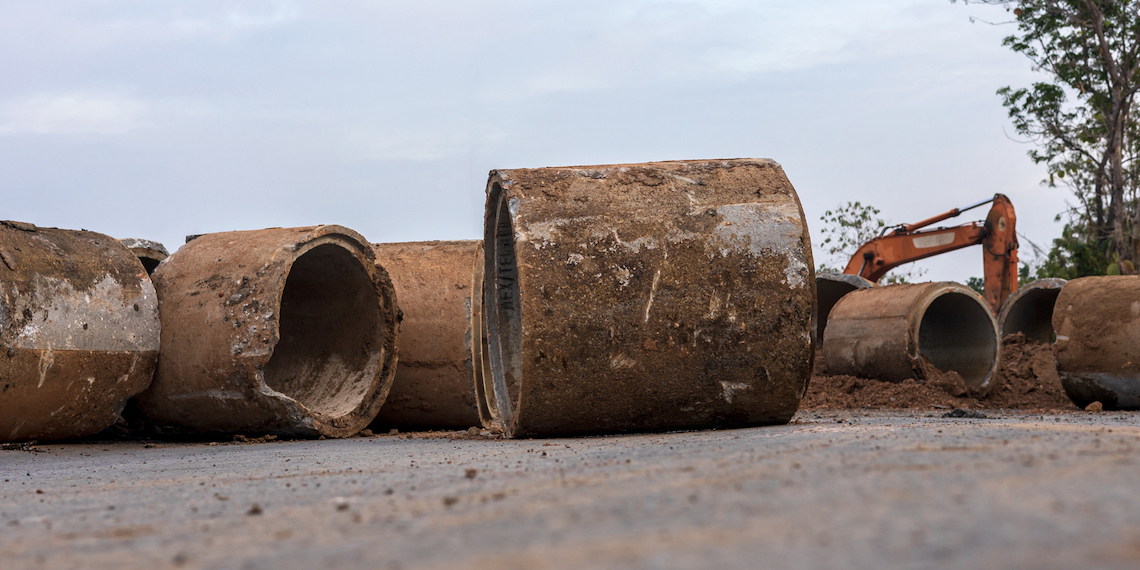World-first project reuses sludge waste for ‘self-healing’ sewer pipes

The need to repair ageing wastewater pipes could one day be obsolete thanks to a sustainable engineering project trialling a novel sludge-based additive that transforms regular concrete into a robust, “self-healing” material.
Corrosive acid from sulfur-oxidising bacteria in wastewater, along with excessive loads, internal pressure and temperature fluctuations, reduce the lifespan of wastewater pipes. This damage costs millions of dollars across Australia to repair every year.
But University of South Australia’s Professor Yan Zhuge said self-healing concrete, in the form of microcapsules filled with water treatment sludge, could be the answer.
“Sludge waste shows promise to mitigate microbial corrosion in concrete sewer pipes because it works as a healing agent to resist acid corrosion and heal the cracks,” Zhuge said.
“The work we are doing in sustainable engineering is about converting industrial waste into green concrete materials. This is, of course, related to reducing carbon emissions within the next couple of decades, and it’s about leaning into the circular economy.
“We are trying to develop new types of concrete that utilse waste that would otherwise end up in landfill, to create high-value construction products.”
The research team is developing microcapsules with a pH-sensitive shell and a healing agent core containing alum sludge and calcium hydroxide powder, a combination highly resistant to microbially induced corrosion.
Embedded inside the concrete at the final step of mixing, the circular-economy innovation is expected to protect new pipes from breakage. When the pH value changes as acid levels build up, the microcapsules will release the healing agents.
Aside from the potential of the new solution to save on maintenance and repair costs, Zhuge said the approach is also a great way of reusing waste to create value.
“Industry by-products or municipal wastes that would normally be discarded in landfill sites, potentially generating pollution, may now be reused in the construction production chain,” she said.
“We are confident this novel self-healing concrete based on advanced composite technology will address issues of sewer pipe corrosion and sludge disposal in one hit.”
Developing innovation
Like many innovations, the idea to create a self-healing concrete for pipe construction came from discoveries within a preceding research project – in this case, the development of retrofitting materials for concrete assets.
“We have been working with SA Water for the past six years to figure out how to reuse drinking water treatment sludge to retrofit or repair sewage pipes,” Zhuge said.
“The initial project, which is now in its final stage, uses treatment sludge to manufacture a new type of mortar-lining material.
“While we were trying to find a way to utilise sludge in concrete as a sand replacement, we found that sludge has some very unique chemical compositions, which have a very high percentage of aluminium and silica. This chemical composition has a unique ability to cure corrosion within sewage pipes.
“The idea of this type of self-healing came from that project. We wanted to move past retrofitting, and consider how we could create new materials for new sewage pipes moving forward, as well.”
Zhuge said the research on creating a “self-healing” concrete for the construction of new sewer pipes is still in early stages, with the project recently receiving a $500,000 Australian Research Council grant.
“At this stage, we have only tested the composite materials, which are intended to be mixed with normal concrete to give it these self-healing properties,” she said.
“First, we intend to keep working on this composite and trial the use of different materials. We have a three-year plan for this research and intend to complete those trials in due course. But it takes time.
“There is a lot of work to be done to find out if this composite mixes well with concrete. We also want to know about the efficiency of these self-healing properties, including how much of the healing agent will be released when a crack occurs, and what sized cracks can be effectively cured.”
Big opportunities
Zhuge said prolonging the lifespan of sewage pipes poses unique challenges, and that the real innovation comes in finding a way to generate self-healing within such a corrosive environment.
“The idea of self-healing is not new. It has been around for a while now. But most technologies are not suitable for sewage pipes. Sewage pipes are different – they are very sensitive to the pH change. And the corrosion is a microbiologically induced corrosion,” she said.
“This new technology we have invented has created a new type of self-healing that is sensitive to pH change. Many other types of self-healing materials are sensitive to mechanically induced force to trigger the self-healing agent in the material.
“In our case, with sewage pipes, we need a technology that reacts to pH, not mechanical force. So that’s where the real innovation is with our new technology.”
Zhuge said another unique aspect of the technology is its reuse of industrial waste, rather than synthetic materials, to induce self-healing.
“Most other research in this area is looking at using synthetic chemicals as a healing agent. We are the first to reuse waste,” she said.
“We have also found that sewage pipes are an excellent candidate for self-healing concrete, because self-healing concrete needs very special conditions to work, which is water. Using this technology to create self-healing in beam and slab structures would be tricky, as there isn’t always water present to activate self-healing properties effectively.
“But, given that sewage pipes are an asset that are in contact with water all the time, they are an excellent candidate for this type of technology.”
